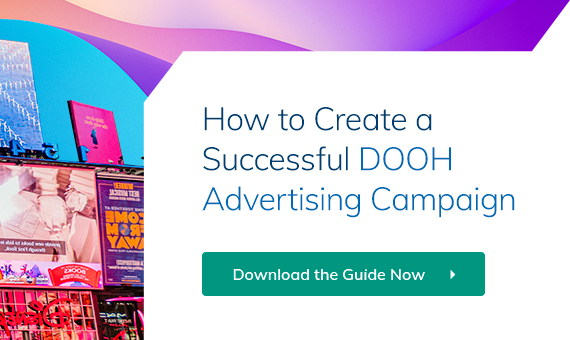In today’s fast-paced digital landscape, reaching the right audience at the right time is crucial – and that’s where location-based digital out-of-home (DOOH) advertising shines.
By combining the physical presence of traditional outdoor ads with the precision of digital targeting, location-based DOOH enables brands to deliver contextually relevant messages that truly resonate.
But how do you ensure your campaigns are hitting the mark? In this blog, we’ll explore smart strategies for identifying and targeting the right audience using location-based DOOH, so you can maximize impact and drive real-world results.
Unlike traditional static billboards, DOOH ads can display content that is responsive to their environment and audience. With DOOH, advertisers can use digital screens and installations to display weather-specific advertisements, show promotions based on real-time sales data, or even interact with consumers through social media feeds.
The increasing proliferation of digital advertising inventory means that US consumers are now exposed to DOOH ads for well over an hour per week – and that figure is growing. Through sheer visual impact, DOOH ads work as a brand awareness tool.
By leveraging technologies like GPS, Wi-Fi, and IP addresses, marketers can use location-based DOOH ads to take this to the next level by targeting potential customers with content that’s relevant to their current position, often resulting in improved engagement and conversion rates.
What are Location-Based DOOH Ads?
Location-based DOOH ads deliver tailored content to consumers based on their geographic location using location intelligence and related technologies. This enables brands to customize DOOH advertising to its local context, increasing its relevance and effectiveness.
There are various types of location-based DOOH advertising:
- Geotargeting involves delivering ads to users within a defined geographical area, such as a city, neighborhood, or specific radius. This approach allows marketers to place DOOH ads near relevant locations, such as areas that are heavily used by commuters.
- Geofencing involves setting up a virtual perimeter around a location and triggering ads when users enter that area.
- Beacon technology uses Bluetooth to deliver ads to users close to a DOOH installation.
For advertisers, one of the key benefits of location-based DOOH ads is their ability to deliver relevant messaging that resonates deeply with audiences. Brands can create a stronger connection with their audience by including location-specific elements such as the name of a region or local landmarks in their DOOH ads.
With Point of Interest or POI targeting, brands can engage consumers with their messaging around a key location, such as a sporting event or popular shopping area. Using event-based messaging, advertisers can create hyper-relevant DOOH ads based on proximity triggers and events, such as targeting commuters with ads for local restaurants during peak hours. And with dayparting and time-of-day targeting, brands can adjust their ad content based on the time of day.
Messages tailored to a specific location are more likely to engage audiences and drive consumer action. Using location-based DOOH ads to reach the right audience at the right time improves campaign efficiency. Such focused campaigns minimize waste, maximize ad effectiveness, and improve the brand’s return on investment (ROI).
The Importance of Location Data for Effective DOOH Advertising
The precision and effectiveness of location-based DOOH ads depends on the accuracy and relevance of the audience and location data available to the advertiser.
Using data analytics and artificial intelligence (AI), brands can gain insights into audience behaviors and preferences, allowing for hyper-personalized ad content.
A study by Forrester found that the use of mobile location data improves conversion rates by an average of 60% and improves the ROI of advertising campaigns by an average of 68%. By gathering information from mobile operators and Wi-Fi radar, and combining it with databases from telecom operators, cash equipment operators, advertising platforms and various internet services, brands can determine the current location of their target audience. Deep analysis can reveal gender, age, income level, and even interests.
In addition to GPS coordinates, location data may also include contextual information such as the current time, weather conditions, and nearby points of interest. This additional information can help advertisers tailor their messaging to the specific audience and environment.
By identifying areas where more people pass, advertisers can pinpoint locations where DOOH ads will have more visibility. A deeper geospatial analysis can highlight locations where marketers can expect similar results after deployment.
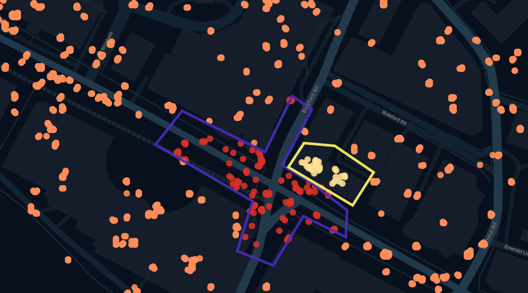
[Image source: Geomotive.io]
Some Successful Examples of Location-Based DOOH Ads
British Airways
For its award-winning “Look Up” campaign, UK national airline British Airways used geolocation data and real-time flight tracking technology to monitor flights passing over digital billboards. In line with these flight details, the billboard display would alter, to show a child pointing upwards to the planes flying over, complete with their flight numbers and destination.
[Video source: YouTube]
The campaign also encouraged viewers to participate via social media, with the hashtag #lookup. Audience participation plus the campaign’s creativity and imagination helped cement British Airways’ reputation as a premium national carrier.
WWF
To raise public awareness about the effects of climate change, the World Wildlife Fund (WWF) used regional climate data to create dynamic DOOH displays which featured lush green landscapes gradually transforming into barren deserts or melting ice caps (depending on the prevailing trend in each area), symbolizing environmental degradation.
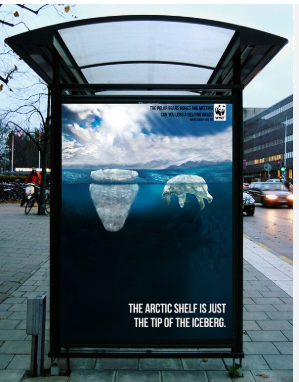
[Image source: TheHypeLoop.com]
By incorporating a call-to-action to support climate initiatives, the campaign created a sense of urgency and inspired immediate action for social causes, succeeding in raising awareness and driving donations.
Burger King
To ease tension and drive sales in gridlocked areas of Brazil’s cities, Burger King used digital billboards to display live traffic conditions along with wait times at nearby outlets. The ads encouraged drivers to use the Burger King app to pre-order meals and pick them up without stepping out of their vehicles.
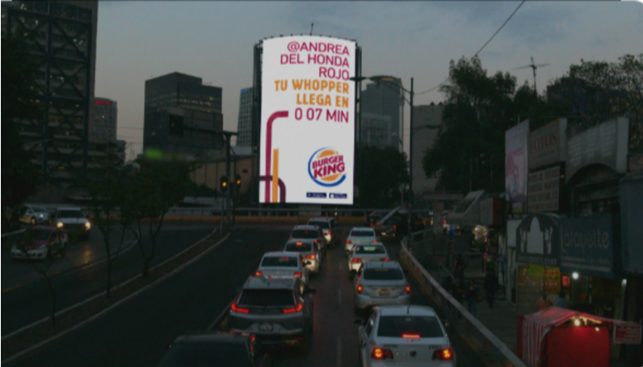
[Image source: TheHypeLoop.com]
By integrating real-time data into an inconvenient situation, the campaign eased the frustration of being stuck in traffic, while increasing app downloads and boosting sales during peak traffic hours.
Oatly
Zooming in to a narrower focus, Oatly’s recent location-based DOOH campaign converted a bus shelter into a decorated sign-post pointing passersby to the nearest coffee shop using its oat milk.
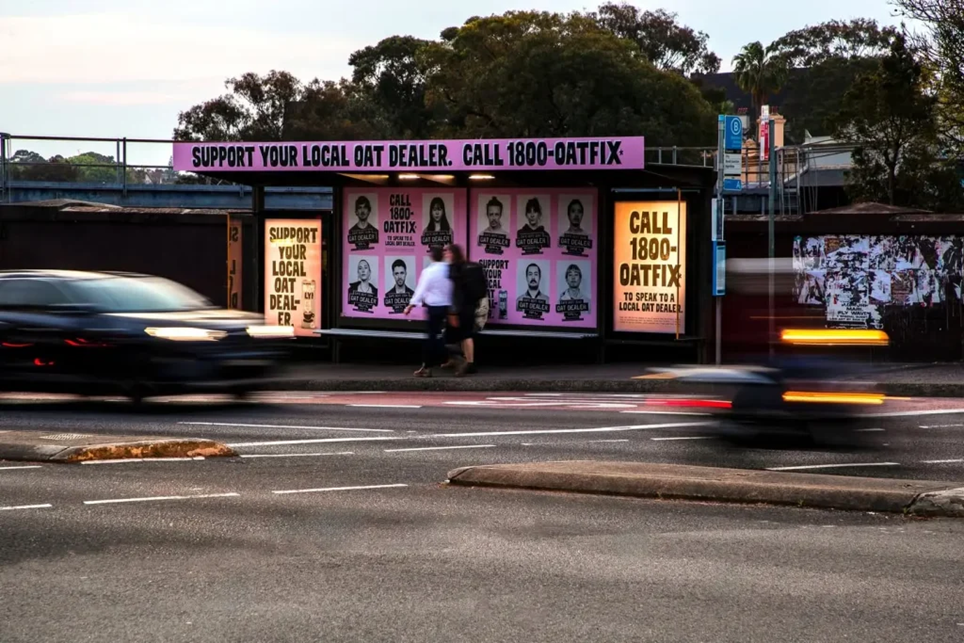
[Image source: oOh! Media]
Beconase
Illustrating that simple visuals and a simple concept can have a telling effect, Beconase used live data to highlight the local pollen count, for an ultra-targeted and relevant campaign message that provided real added value for the audience.
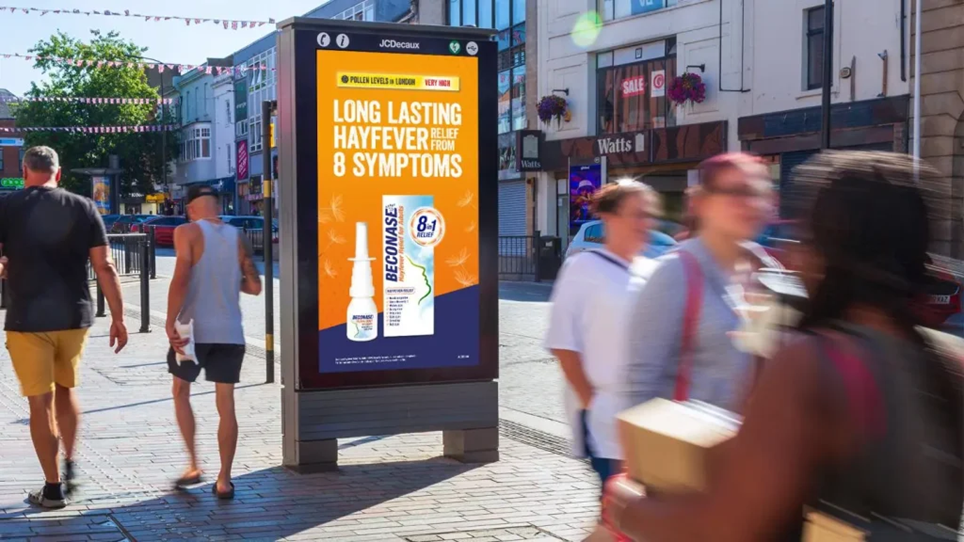
[Image source: JCDecaux]
Best Practices and Recommendations
In light of the above examples, and what we have observed so far about location intelligence and audience data, here are some recommendations for deploying your location-based DOOH ads:
- Use audience data to target specific demographics, behaviors, and interests.
- Use location data to identify high-traffic areas and tailor messages to specific locations.
- Use POI targeting to surround consumers with your message around a key location.
- Adjust content based on the time of day, and serve hyper-relevant ads based on proximity triggers and events.
- Use location data in conjunction with programmatic DOOH (pDOOH), to identify the most impactful sites for targeted ads, and the best time to run ads to reach target audiences.
Get Started with Location-Based DOOH Ads with The Neuron
With a pDOOH platform, you can use location data from mobile technologies to set conditions on your bids. Your ad only appears when your target audience is in proximity to your digital screen, allowing you to target ready-to-buy audiences and maximize ROI.
Specializing exclusively in pDOOH, The Neuron enables advertisers to automatically activate campaigns based on user actions, time, weather, inventory changes, or trends for timely, relevant ads. The platform offers a unique bidding technology which utilizes a smarter, more dynamic algorithm to deliver higher-impact ad placements at lower costs for clients.
To learn more about how The Neuron can help you target the right audience with location-based DOOH ads, contact us today.
